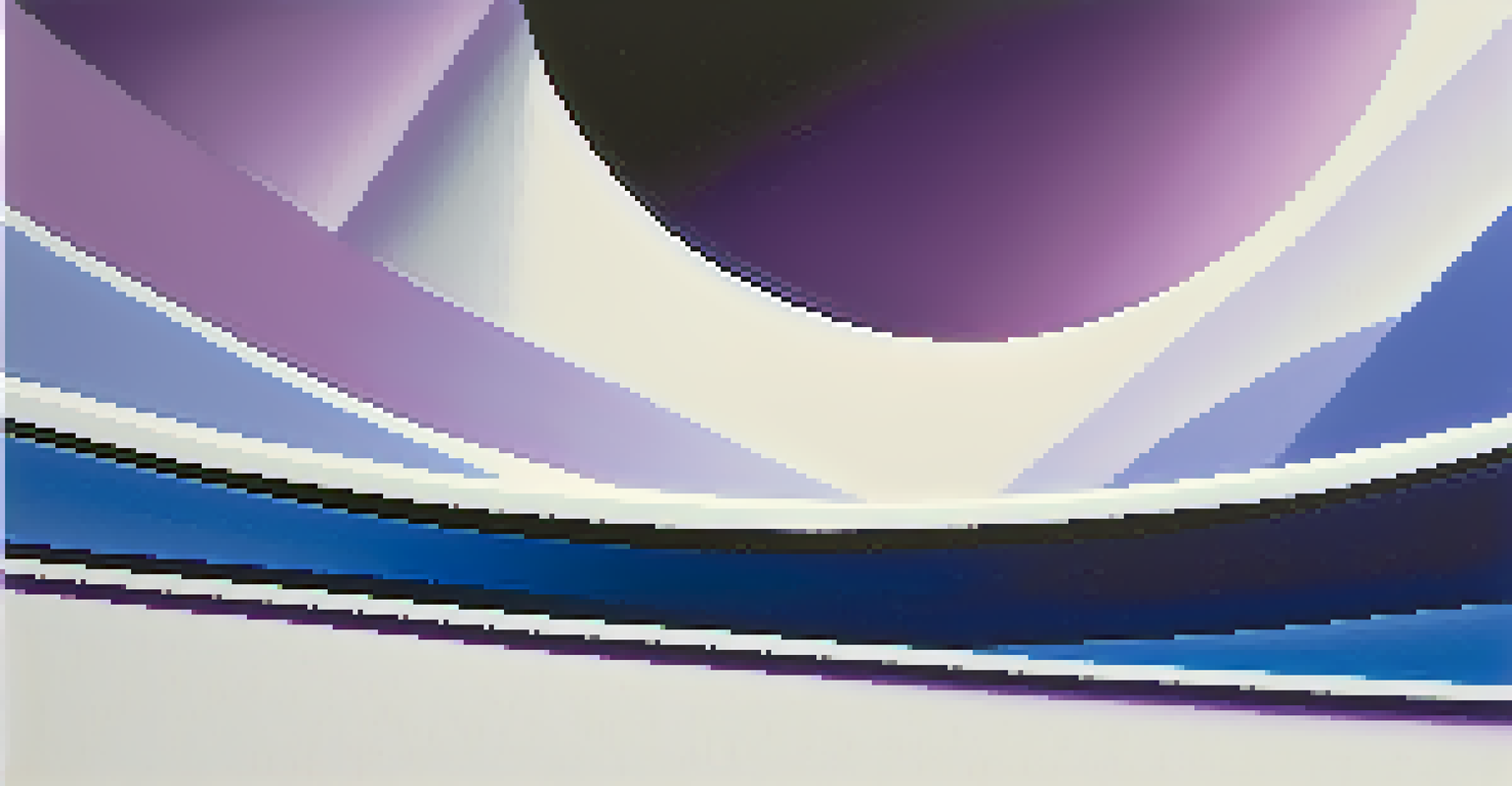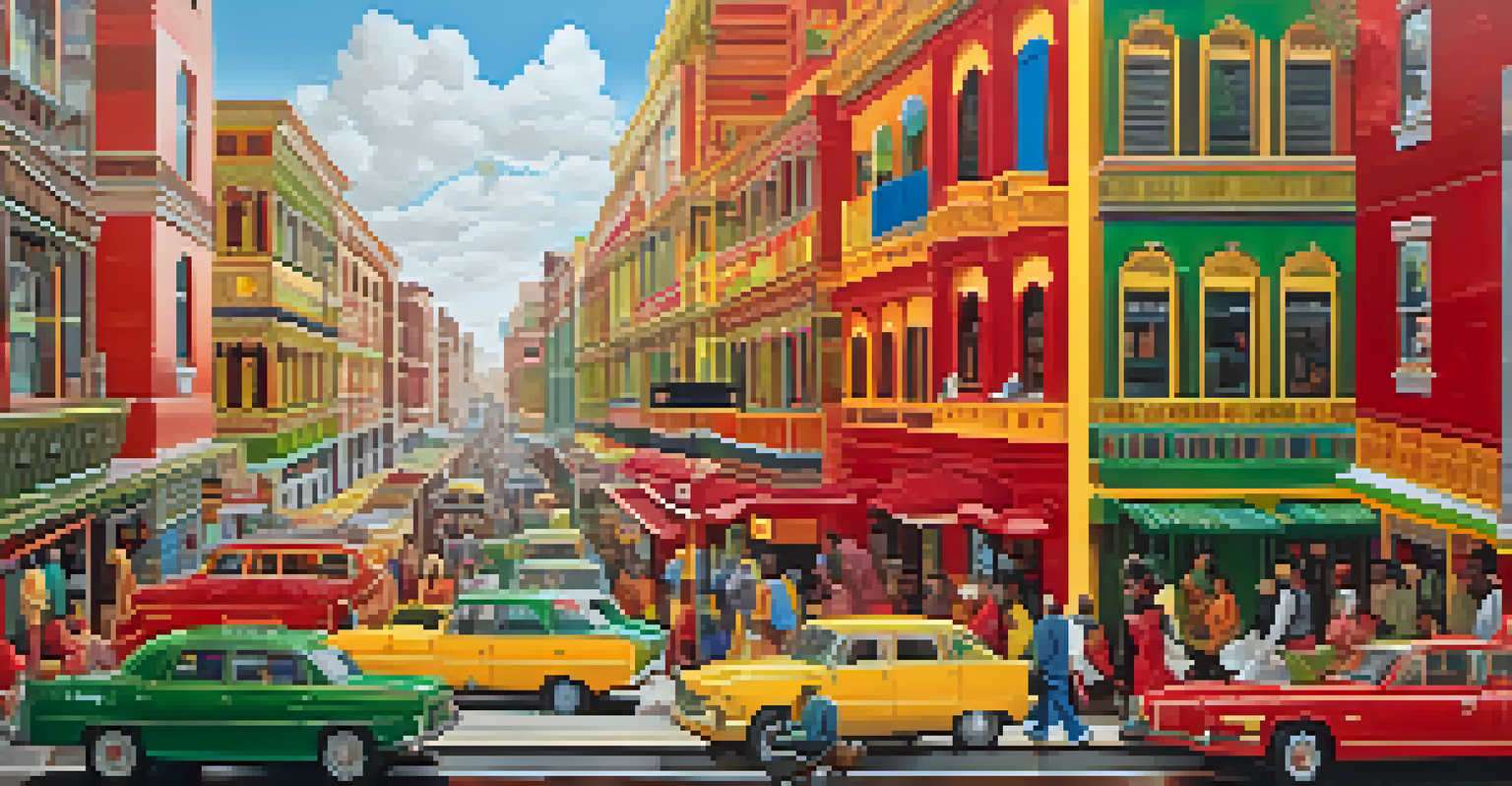The Emotional Language of Lines and Shapes in Visual Art

Understanding the Basics of Lines in Visual Art
Lines are fundamental elements in visual art, acting as the building blocks for more complex forms. They can be straight, curved, thick, or thin, each variation carrying its own emotional weight. For instance, sharp, jagged lines often evoke feelings of tension or chaos, while soft, flowing lines can create a sense of calm and tranquility. By recognizing these subtle differences, viewers can begin to decode the emotional language that lines communicate.
Art is the most beautiful of all lies.
Artists intentionally choose specific types of lines to enhance the narrative of their work. Take, for example, the famous painting 'Starry Night' by Vincent van Gogh. The swirling lines depict a night sky that feels alive, pulsating with emotion and movement. This illustrates how lines can create not just a visual structure but also an emotional atmosphere, guiding the viewer's feelings and reactions.
Moreover, lines can lead the eye through an artwork, creating a journey for the viewer. A line that directs attention can amplify the emotional response to the subject matter. Understanding the role of lines in art allows us to appreciate the underlying emotions that the artist seeks to convey.
The Role of Shapes in Conveying Emotion
Shapes, like lines, play a crucial role in the emotional language of art. They can be geometric, organic, or abstract, each type evoking different feelings and interpretations. For example, circular shapes often symbolize unity and harmony, while sharp, angular shapes may suggest conflict or instability. By analyzing the shapes present in a piece, viewers can gain insight into the emotions the artist intends to express.

Consider the use of shapes in Picasso's 'Guernica.' The distorted forms and sharp angles reflect the chaos and suffering of war. This powerful representation showcases how shapes can embody complex emotions and narratives, transforming a simple image into a profound statement about human experience.
Lines Convey Emotional Depth
Lines in visual art serve as fundamental elements that communicate various emotions, enhancing the viewer's experience.
Furthermore, shapes can create a sense of balance or imbalance within a composition. An artwork filled with chaotic, irregular shapes may evoke feelings of unease, while a piece dominated by balanced, symmetrical shapes can instill a sense of peace. By recognizing these patterns, we can better understand the emotional depth of the artwork.
Combining Lines and Shapes for Greater Impact
The interplay between lines and shapes can amplify the emotional message of a piece. Artists often combine different types of lines and shapes to create a multi-layered experience. For example, in abstract art, the chaos of intersecting lines and overlapping shapes can evoke a whirlwind of emotions, from confusion to excitement. This combination allows artists to communicate complex ideas in a visually engaging manner.
Every artist dips his brush in his own soul, and paints his own nature into his pictures.
Moreover, the juxtaposition of soft lines and harsh shapes can create tension, enhancing the emotional narrative. An artist might use gentle curves surrounding a sharp triangle to signify protection amid danger. This contrast invites the viewer to explore the emotional nuances within the artwork and fosters a deeper connection to the piece.
As we observe these combinations, we can appreciate the thoughtfulness behind an artist's decisions. Each line and shape is chosen with intention, contributing to the overall emotional landscape of the artwork. This understanding enriches our experience and appreciation of visual art.
Cultural Influences on the Emotional Language of Art
Cultural context plays a significant role in how lines and shapes are interpreted in art. Different cultures attribute various meanings to specific shapes and line styles, which can influence emotional responses. For instance, in Western cultures, a circle often symbolizes eternity, while in some Eastern traditions, it may represent the cyclical nature of life. Understanding these cultural nuances enhances our interpretation of an artwork's emotional message.
Consider the use of lines in Indigenous art, where intricate patterns and shapes convey deep cultural stories and emotions. The lines may represent pathways, connections to the land, or community ties. These culturally specific interpretations can shape how we perceive the emotional content of the work, reminding us of the diverse ways art communicates feelings.
Shapes Influence Viewer Perception
Different shapes evoke distinct emotional responses, offering insight into the artist's intended message.
By recognizing the cultural influences on lines and shapes, we can approach art with a more informed perspective. This awareness allows us to appreciate the layers of meaning that contribute to the emotional language of visual art, ultimately enriching our viewing experience.
Emotional Resonance: Viewer Interpretation of Lines and Shapes
The emotional language of lines and shapes isn't solely dictated by the artist; viewers bring their own experiences and emotions into the interpretation. Each person may respond differently to the same artwork based on their background, feelings, and associations. This variability creates a rich tapestry of emotional responses, making art a deeply personal experience.
For example, a viewer may see a chaotic swirl of lines as a representation of anxiety, while another might interpret it as excitement. This subjectivity highlights the power of art to resonate with diverse audiences, allowing for multiple emotional interpretations. Artists often embrace this idea, knowing that their work can evoke a range of feelings depending on who is engaging with it.
Understanding that each viewer's emotional response is valid encourages deeper conversations about art. These discussions can uncover the layers of meaning behind lines and shapes, fostering a sense of community and shared experience among art lovers. In this way, the emotional language of visual art becomes a bridge connecting individuals through their unique interpretations.
The Evolution of Lines and Shapes in Contemporary Art
Contemporary art has pushed the boundaries of how lines and shapes are used to convey emotion. Artists today experiment with a variety of materials and techniques, often blurring the lines between traditional and modern forms. This evolution reflects the changing dynamics of society and the complex emotions that come with it, allowing for new interpretations and expressions through visual language.
For instance, digital art has introduced new possibilities for manipulating lines and shapes, creating immersive experiences that engage viewers on multiple levels. Artists can now play with scale, movement, and color, further enhancing the emotional impact of their work. As technology advances, so does the potential for innovative emotional expression in art.
Cultural Context Shapes Interpretation
Cultural influences significantly affect how lines and shapes are interpreted, enriching the emotional language of art.
By exploring these contemporary developments, we can appreciate how the emotional language of lines and shapes continues to evolve. This ongoing transformation invites us to rethink our understanding of art and its capacity to communicate feelings, ensuring that the conversation around emotion in visual art remains vibrant and dynamic.
Recognizing Your Emotional Responses to Art
As viewers, it's essential to recognize and reflect on our emotional responses to lines and shapes in art. Taking a moment to pause and consider how a piece makes us feel can deepen our connection to the artwork. Whether it evokes joy, sadness, or contemplation, acknowledging these feelings allows us to engage more fully with the art.
One effective way to explore these emotions is through journaling. After viewing a piece, jot down your immediate feelings and thoughts about the lines and shapes. This practice not only enhances your understanding of the work but also encourages a deeper appreciation of the artist's intentions and emotional language.

Ultimately, recognizing your emotional responses helps you become a more engaged viewer. As you explore the emotional landscape of lines and shapes, you cultivate a richer relationship with art, one that allows for personal interpretation and connection. This journey enhances not only your appreciation of visual art but also your understanding of your own emotional world.